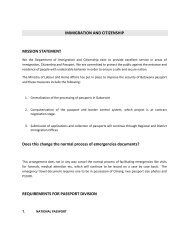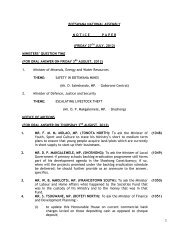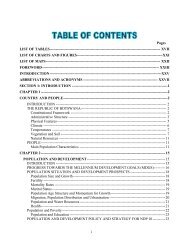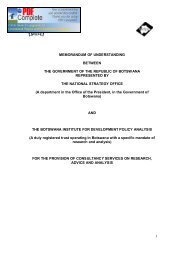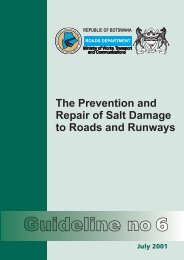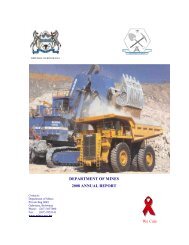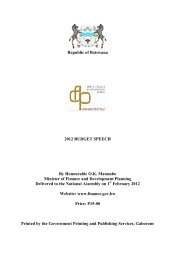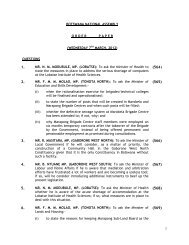National Nutrition and HIV/AIDS Guidelines for Service Providers of ...
National Nutrition and HIV/AIDS Guidelines for Service Providers of ...
National Nutrition and HIV/AIDS Guidelines for Service Providers of ...
You also want an ePaper? Increase the reach of your titles
YUMPU automatically turns print PDFs into web optimized ePapers that Google loves.
4.3.3 Clinical<br />
The key in clinical assessment is to identity physical manifestation <strong>of</strong> nutrient deficiencies or excesses.<br />
This requires a lot <strong>of</strong> skill <strong>and</strong> experience. Careful examination <strong>of</strong> eyes, h<strong>and</strong>s, fingers, hair, mouth,<br />
gums <strong>and</strong> skin, tummy <strong>and</strong> body shape can provide valuable in<strong>for</strong>mation <strong>for</strong> nutrition assessment.<br />
4.3.4 Dietary<br />
Dietary assessment evaluates the adequacy <strong>of</strong> the food <strong>and</strong> the nutrients consumed. This involves<br />
assessment <strong>of</strong> eating patterns, frequency <strong>of</strong> meals <strong>and</strong> the factors influencing the choice <strong>of</strong> food<br />
procured. The underlining objective is to establish the client's ability to consume enough amounts <strong>and</strong><br />
variety <strong>of</strong> food to meet his/her needs. A variety <strong>of</strong> methods are available <strong>for</strong> use. Some <strong>of</strong> these are<br />
food records, dietary history, 24-hr recalls <strong>and</strong> food frequency. The choice <strong>of</strong> the method should match<br />
the characteristic <strong>of</strong> the clients. It is best to use a combination <strong>of</strong> methods that will adequately reflect<br />
the clients' usual intake, current intake, dietary preferences <strong>and</strong> practices, food intolerances <strong>and</strong> any<br />
dietary changes that may undermine dietary intake. Dietary assessment should also capture<br />
in<strong>for</strong>mation regarding the use <strong>of</strong> food supplements or substances used as such.<br />
4.3.5 Environmental status<br />
The physical, psycho-social <strong>and</strong> economic environment in which PLWA live may also influence their<br />
nutritional status. These environments may negatively affect food security, balance <strong>and</strong> variety in<br />
diet, frequency <strong>of</strong> meals <strong>and</strong> methods <strong>of</strong> food preparation. For example, PLWHA who are temporarily<br />
debilitated by illnesses may find it difficult to purchase, prepare, <strong>and</strong> eat food, while poverty, lack <strong>of</strong><br />
refrigeration or lack <strong>of</strong> appropriate cooking facilities, may restrict the choice <strong>of</strong> food. Some PLWHA<br />
may also find it difficult to access social safety net programs or fail to collect their food supply if<br />
already enrolled in safety net programs. The amount <strong>of</strong> food consumed at each sitting may also be<br />
restricted by factors such substance / alcohol abuse, depression or senile dementia. All these factors<br />
have a bearing on the overall nutritional status <strong>of</strong> PLWHA <strong>and</strong> should receive prompt attention as do the<br />
ABCDs <strong>of</strong> nutritional assessment.<br />
Proper utilization <strong>of</strong> nutritional assessments methods enables providers to<br />
° Establish the correct nutritional status <strong>of</strong> PLWHA<br />
° Confirm the adequacy <strong>of</strong> recommended interventions <strong>and</strong> prompt providers to review<br />
the interventions.<br />
° Confirm the absence <strong>of</strong> illnesses that aggravate nutritional wastage <strong>and</strong> provide<br />
treatment <strong>for</strong> illnesses that reduce food intake.<br />
° To adjust meals <strong>and</strong> meal plans <strong>for</strong> other chronic illnesses associated with <strong>HIV</strong>.<br />
° To facilitate provision <strong>of</strong> therapeutic nutritional care <strong>and</strong> support PLWHA<br />
22



